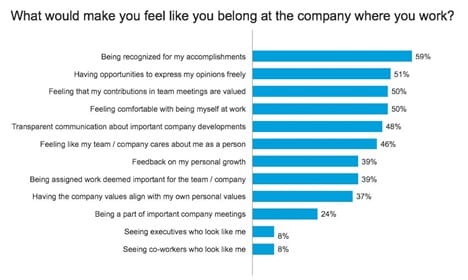Volume 38 Number 1 | February 2024
Phyllis Ingham, EdD, MLS(ASCP)CM, AHI(AMT), ASCLS Today Volunteer Contributor

According to psychologist Abraham Maslow, “a sense of belonging is not just essential to good health, a lack of love and belonging will prevent a person from feeling esteem and reaching self-actualization.” In layman terms that means, not feeling loved or belonging often leads to a negative self-concept and even a sense of failure in anything we do in life. If you remember studying psychology, Maslow basically stated as humans we all have five basic needs:
- physiological needs
- the need to feel safe
- the need for love and belonging
- the need for esteem
- the need for self-actualization
All five of these needs must be met in our lives for us to achieve “Psychology Safety,” or what is more commonly referred to as a “Sense of Community.” The sense of community allows individuals to experience a climate in which people are comfortable expressing themselves and being themselves. In any organization, once a “sense of community” is established, individuals will resonate with these four elements (feelings): membership, influence, integration, and shared emotional connection. This allows trust, confidence, and respect for individuality, diversity, inclusiveness, and a positive sense of belonging within the community.
Belonging in the Workplace
Let’s take a look at what effect “belonging” has in the workplace environment. According to Maxwell Huppert, studies show that feeling a sense of belonging in the workplace leads to more than just good vibes and friendships. Supportive environments trigger different responses in the brain, leading to better collaboration and problem solving. A recent survey asking employees what would make them feel they belonged where they work clearly indicates today’s employees have a driven desire to be seen, heard, and valued as individuals. Nearly 60 percent of all respondents indicated “being recognized for accomplishments at work” was the largest single contributor to an overall sense of belonging. Almost as equally important, 51 percent indicated having opportunities to “express my opinions freely,” and 50 percent answered, “feeling that my contributions in the team meetings are valued.” (See survey results below).
So, we ask ourselves, what steps can leadership take to ensure a community of belonging in our workplace environments?
1. Recognize Unique Efforts of the Individual
Often times, simple gestures are both impactful and a cost-effective way to make employees feel valued. Some examples include allowing employees to announce big wins, honoring work anniversaries, and provide unique award programs that go beyond the standard “employee of the month.” It is also important to note that not every employee will enjoy being recognized in public but may prefer a more private message or reward which means direct supervisors or managers/team leaders must “know” their team for this to be accomplished.
2. Acknowledge and Appreciate Employee Contributions and Value
Leadership should be able to show employees their contributions are valuable by simply listening respectfully and attentively.
3. Practice Candor and Give Employees Opportunities to Share Honest Opinions
Leadership must make it known employees’ contributions are valued and that expressing thoughts, views, and opinions will foster an open and honest safe work environment. This allows for honest opinions to be shared, even if those opinions go against the status quo.
4. Ask Important Inclusive Leadership Questions
According to renowned leadership author John Maxwell, “every person has a unique value to bring to the team.” It is the responsibility of leaders to invite everyone on the team to the table to be able to be seen, heard, and feel welcome. Maxwell suggests that, as inclusive leaders, we must ask ourselves three basic questions.
- Do you SEE ME? When you really “see” someone, you give them your undivided attention, which is evidenced by direct eye contact, active listening, and a genuine interest in the person and what they are saying to you. When people feel “seen,” they embrace the feeling of being included and belonging.
- Do you VALUE ME? Am I valued as a person and a team member? Do you value my thinking and invite me to contribute to the conversation? When you encourage all members of your team to contribute, you send the message that every team member matters.
- Do you INLCUDE ME? Leaders can ensure their team is included by truly assuring them they do NOT have ALL the answers. “I need your help” in brainstorming for setting goals, problem solving, decision making, and I want you on the team.
Personal Belonging
Belonging is closely tied to our personal well-being and mental health. Since humans are inherently social creatures, our sense of self-worth and even happiness often stems from connections we develop in our workplaces. Many articles have been written discussing how the lack of social belonging can lead to feelings of loneliness, depression, and even cause physical health related problems. It has also been noted that strong social ties and a sense of belonging are associated with increased life satisfaction and resilience in the face of adversity.
Belonging is not just about “fitting in”; it is also about personal growth. When we belong to communities and groups that support our values, interests, and aspirations, we often see this as a catalyst for self-improvement. When individuals feel they are a part of a supportive environment, this challenges us to expand our horizons, learn new skills, and even take risks, because we know we have a community of supporters that serve as our safety-net if things do not go as planned. If we fail, we know we can try again, which builds resiliency and provides the motivation to keep moving forward, even during times of adversity.
In conclusion, leadership in the laboratory profession plays a crucial role in fostering a profound sense of belonging in the workplace, transforming it into much more than just a professional setting. By prioritizing inclusivity, acknowledging individual contributions, and embracing diversity, leaders build a community where every member feels a genuine sense of “belonging,” thus creating a culture that values not only the expertise but also the unique qualities each laboratory healthcare professional brings to the team. This community creates a collective identity that goes far beyond roles and responsibilities. Special bonds are formed that make the laboratory profession not just a place of work but a “home” where every member belongs and thrives. Welcome home to our laboratory family!
References
- Edmondson, Amy C. (2019). The fearless organization: creating psychological safety in the workplace for learning, innovation, and growth. New Jersey: John Wiley & Sons, Inc.
- Employees share What Gives them a Sense of Belonging at Work. Retrieved from http://business.linkedin.com/talent:solutions/blog/company-culture/2017/employees:share-what-gives-them-a-sense-of-belonging-at-work
- Fostering The Sense of Belonging Promotes Success. Retrieved from https://www.forbes.com/sites/johnbaldoni/2017/01/22/fostering-the-sense-of-belongingpromotes-success/
- Gibson, Emily., Barr, Robert. (2013) Creating a Culture of Hope.
- Kouzes, James M., & Posner, Barry. Z. (2017). The leadership challenge. (6th ed). John Wiley & Sons.
- Maslow, A.H. (1943). A Theory of human motivation. Psychological Review, 50(4), 370-396.
- Maxwell, John. C. (2017). The Power of your Leadership: Making a Difference with Others. New York: Center Street Hachette Book Group.
- McMillan, David. W. & Chavis, David. M. (1986) Sense of Community: A Definition and theory. Journal of Community Psychology, 14(1), 6-23.
Phyllis Ingham is Program Director of Medical Laboratory Technology at West Georgia Technical College in Waco, Georgia.
